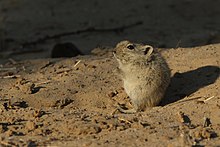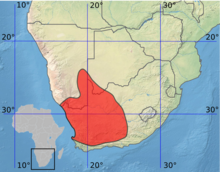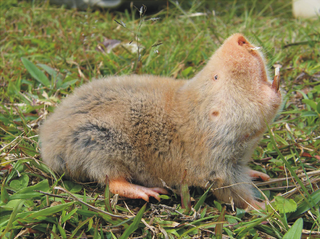
The silvery mole-rat, silvery blesmol, or silky mole-rat is a species of mole-rat of East Africa which occurs in southern Kenya, Tanzania, southeastern Democratic Republic of Congo, Mozambique and Malawi. Solitary and aggressive, little is known about its ecology or behavior. It is monotypic in the genus Heliophobius. A common species, the International Union for Conservation of Nature has rated it as being of "least concern".

The pale field rat is a small rat endemic to Australia. It is a nocturnal and herbivorous rodent that resides throughout the day in shallow burrows made in loose sand. Once widespread, its range has become greatly reduced and it is restricted to the grasslands, sedges, and cane-fields at the north and east of the continent. Its fur is an attractive yellow-brown colour, with grey or cream at the underside. This medium-sized rat has a tail shorter than its body.
The Western Saharan spiny mouse or Aïr spiny mouse is a species of small, insectivorous rodent in the family Muridae found arid regions of western Africa.
The dark bolo mouse or dark-furred akodont is a species of rodent in the family Cricetidae. There are two subspecies; one is found in eastern and central parts of Buenos Aires Province, Argentina, and the other in coastal areas of southern Uruguay.
The West African shaggy rat is a species of rodent in the family Muridae. It is found in Benin, Cameroon, Ivory Coast, Gambia, Ghana, Guinea, Guinea-Bissau, Liberia, Mali, Nigeria, Senegal, Sierra Leone, and Togo. Its natural habitats are subtropical or tropical seasonally wet or flooded lowland grassland and swamps. It is a common species and the International Union for Conservation of Nature has rated its conservation status as being of "least concern".
The Namib brush-tailed gerbil or Setzer's hairy-footed gerbil is a species of rodent endemic to Angola and Namibia. Its natural habitats are sandy and gravelly plains. It stays in its burrow by day, emerging at night to feed on arthropods, vegetable matter, and seeds.
The Mount Oku rat is a species of rodent in the family Muridae. It is the only species in the genus Lamottemys. It is found only in Cameroon where its natural habitat is subtropical or tropical moist montane forests. It is threatened by habitat destruction.
Lemniscomys linulus, commonly known as the Senegal grass mouse or Senegal one-striped grass mouse, is a species of rodent in the family Muridae. It is found in Ivory Coast, Guinea, Mali, and Senegal and its natural habitat is dry savanna. At one time considered to be a subspecies of Lemniscomys griselda, it is now accepted as a species in its own right.
Mittendorf's lemniscomys or Mittendorf's striped grass mouse is a species of rodent in the family Muridae. It is endemic to Cameroon where it is found at high elevations on a single mountain. Its natural habitat is tropical high-altitude grassland. It faces no particular threats and the International Union for Conservation of Nature has listed it as being of "least concern".
The Ethiopian forest brush-furred rat or golden-footed brush-furred rat, is a species of rodent in the family Muridae. It is endemic to Ethiopia where its natural habitat is subtropical or tropical moist montane forests. It is threatened by habitat loss.

The Southern African vlei rat is a species of rodent in the vlei rat genus, Otomys, of the family Muridae in the order Rodentia. This is the type species of the genus. It is native to the grasslands and swamps of southern Africa where it is a common species.
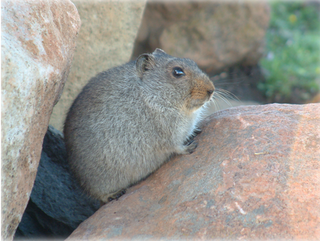
Sloggett's vlei rat or ice rat is a species of rodent in the family Muridae. It is found in southern Lesotho and South Africa where its natural habitats are subtropical or tropical high-altitude grassland, swamps, and rocky areas. Its name commemorates Col. Arthur Sloggett who served in South Africa and collected at Deelfontein in 1902. This is a common species and the International Union for Conservation of Nature has rated it as being of "least concern".

The bush vlei rat or Karoo bush rat is a species of rodent in the family Muridae. It is found in Namibia and South Africa. Its natural habitat is temperate shrubland. The Karoo rat uses behavioral adaptations to cope with the dry arid climate. It is a medium-sized rodent with a dark pelage on top and lighter underneath. It has light colored feet and a dark tail. The rat may have light colored fur around its eyes and the back of its ears.

Parotomys is a small genus of rodent in the family Muridae. Member species are found in the African countries of Botswana, Namibia, and South Africa. It contains the following two species:
Littledale's whistling rat is one of two species of murid rodent in the genus Parotomys, the other being Brants's whistling rat. It is found in Namibia and South Africa. Its natural habitats are temperate shrubland, subtropical or tropical dry shrubland, and temperate desert.
Boehm's gerbil is a species of rodent found in Angola, Burundi, Democratic Republic of the Congo, Kenya, Malawi, Mozambique, Rwanda, Tanzania, Uganda, and Zambia. Its natural habitats are dry savanna, moist savanna, and arable land. This is a common species with a wide distribution which faces no obvious threats, so in 2004 the International Union for Conservation of Nature rated its conservation status as being of "least concern".
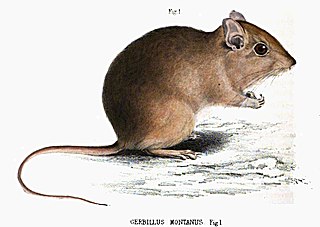
The highveld gerbil is a species of rodent found in Angola, Botswana, Lesotho, Namibia, South Africa, Eswatini, Zambia, and Zimbabwe. Its natural habitats are dry savanna, temperate shrubland, subtropical or tropical dry shrubland, temperate grassland, and temperate desert. This is a common species with a wide range and the International Union for Conservation of Nature has rated it as being of "least concern" as of 2008.

Bennett's chinchilla rat is a species of chinchilla rat in the family Abrocomidae. It is found only in Chile where its habitat is Mediterranean-type scrub on the western side of the Andes. The IUCN has assessed its conservation status as being of "least concern".
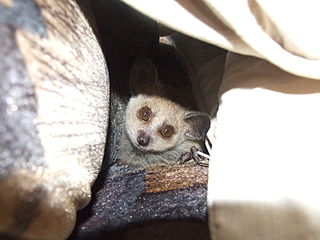
Grant's bushbaby, also known as Grant's lesser bushbaby or the Mozambique lesser bushbaby, is a species of primate in the family Galagidae. It is found in Malawi, Mozambique, Tanzania, and Zimbabwe. Its natural habitat is subtropical or tropical dry forests. It is a common species and the International Union for Conservation of Nature has assessed its conservation status as being of "least concern".
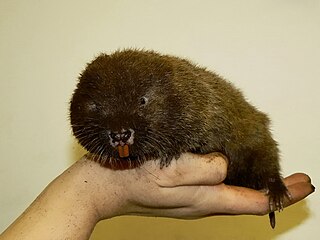
The lesser bamboo rat is a species of rodent in the family Spalacidae. It is monotypic within the genus Cannomys. It is found in Bangladesh, Bhutan, Cambodia, China, India, Myanmar, Nepal, and Thailand.
